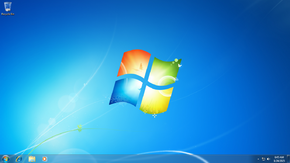Template:Infobox Windows version
| Version of Microsoft Windows | |
Template documentation [view] [edit] [history] [purge]
This infobox provides essential information on versions of Windows.
Usage
| Version of Microsoft Windows | |
 Desktop | |
| OS family | Windows NT |
|---|---|
| Version | 6.1 |
| Codename | Windows 7 |
| Architecture | x86, x64 |
| Latest build | 6.1.7600.16385 |
| Release date | 2009-10-22 |
| Support end | 2020-01-14 |
| Server counterpart | |
| Windows Server 2008 R2 | |
| Replaces | |
| Windows Vista | |
| Replaced by | |
| Windows 8 | |
The following code will result in the infobox to the right side:
{{Infobox Windows version
|name = Windows 7
|logo = Windows 7.svg
|codename = Windows 7
|image = Windows7-RTM-DesktopAero.png
|image-caption = Desktop
|family = nt
|version = 6.1
|arch = x86, x64
|latestbuild = [[Windows 7 build 7600.16385|6.1.7600.16385]]
|releasedate = 2009-10-22
|support = 2020-01-14
|server = [[Windows Server 2008 R2]]
|sku = Starter<br>Home Basic<br>Home Premium<br>Professional<br>Enterprise<br>Ultimate
|replaces = [[Windows Vista]]
|replaced-by = [[Windows 8]]
}}
name
The marketing name for the particular Windows release. If not provided, it gets automatically filled in according to family and version values, therefore name should be omitted for pre-1995 Windows versions.
family
This describes the product line the particular Windows release belongs to. This parameter has the following legal values, which expand to the respective descriptions:
16⇒ 16-bit Windows9x⇒ Windows 9xnt⇒ Windows NT (up to, including, Windows 10 original release)10⇒ Windows 10 (NT 10.0) (Windows 10 November Update and newer)11⇒ Windows 11 (NT 10.0)
version
This is the version number of the particular Windows release. For families 16, 9x, nt this should be a rational number with up to two decimal points. Don't prefix the version number with anything.
Between Windows 10 November Update and Windows 10 May 2020 Update (family 10), this is a four-digit number that happens to be a date in the YYMM. Please note that the marketing name might not always reflect the version number, e.g. Windows 10 April 2018 Update is actually version 1803 and not 1804 as one would expect!
Since Windows 10 October 2020 Update (families 10 and 11), this is a YYHx formatted string, where YY is the last two digits of the year and Hx marks the year's half, i.e. the release in the first half is H1, while a release in the second half is H2.
codename, preliminary
Codenames and preliminary names for the particular Windows release, if any. Please distinguish between a codename, which is only an internal term used to refer to the product (i.e. Whistler Server) and a preliminary name, which is an official name that has been abandoned before the final release (i.e. Windows .NET Server 2003).
semester
For Windows 10 May 2019 Update and later, this is the name of the semester that this release was released on, such as Cobalt or Vanadium.
arch
A listing of architectures supported by the particular Windows release. Tends to be one or more of the following:
- x86
- x64
- DEC Alpha
- MIPS
- PPC
- PC-98
- IA-64
- ARM32
- ARM64
latestbuild
Link to the latest build of the particular Windows release.
releasedate
The original release date of the particular Windows release, e.g. 1985-11-20 for Windows 1.0.
support
The end of support date for the particular Windows release.
sku
List of the SKUs/editions that the particular Windows release was officially available in, separated by <br> tags.
based-on, client, replaces, replaced-by, server
Use these parameters to link to the versions of Windows that the particular release is related to. If this applies only to a specific SKU of that version, the link should mention the SKU in question, e.g. Windows 2000 Professional. replaces and replaced-by shall link to the versions that this particular Windows release replaces or is replaced by, while server or client should link to the server/client counterpart.
based-on should be used in cases the particular Windows release builds upon another version to provide some specific functionality, e.g. Windows Thin PC is based on Windows Embedded POSReady 7, which in turn is based on Windows 7.